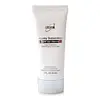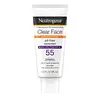What's inside
What's inside
 Key Ingredients
Key Ingredients

 Benefits
Benefits

 Concerns
Concerns

 Ingredients Side-by-side
Ingredients Side-by-side

Homosalate 7.5%
Skin ConditioningEthylhexyl Salicylate 4.5%
UV AbsorberTitanium Dioxide 2.2%
Cosmetic ColorantZinc Oxide 12.7%
Cosmetic ColorantWater
Skin ConditioningCyclopentasiloxane
EmollientDipropylene Glycol
HumectantDisiloxane
Skin ConditioningLauryl PEG-10 Tris(Trimethylsiloxy)Silylethyl Dimethicone
EmulsifyingGlycerin
HumectantNiacinamide
SmoothingPropylheptyl Caprylate
EmollientPortulaca Oleracea Extract
Skin ConditioningSilica
AbrasiveDimethicone
EmollientDisteardimonium Hectorite
StabilisingMagnesium Sulfate
1,2-Hexanediol
Skin ConditioningVinyl Dimethicone/Methicone Silsesquioxane Crosspolymer
Triethoxycaprylylsilane
Aluminum Hydroxide
EmollientStearic Acid
CleansingSorbitan Caprylate
EmulsifyingDimethicone/PEG-10/15 Crosspolymer
Parfum
MaskingDimethicone/Vinyl Dimethicone Crosspolymer
Skin ConditioningGlyceryl Caprylate
EmollientEthylhexylglycerin
Skin ConditioningAdenosine
Skin ConditioningTocopherol
AntioxidantCamellia Sinensis Leaf Extract
AntimicrobialMelilotus Officinalis Extract
AstringentCentella Asiatica Extract
CleansingPerilla Ocymoides Leaf Extract
TonicHomosalate 7.5%, Ethylhexyl Salicylate 4.5%, Titanium Dioxide 2.2%, Zinc Oxide 12.7%, Water, Cyclopentasiloxane, Dipropylene Glycol, Disiloxane, Lauryl PEG-10 Tris(Trimethylsiloxy)Silylethyl Dimethicone, Glycerin, Niacinamide, Propylheptyl Caprylate, Portulaca Oleracea Extract, Silica, Dimethicone, Disteardimonium Hectorite, Magnesium Sulfate, 1,2-Hexanediol, Vinyl Dimethicone/Methicone Silsesquioxane Crosspolymer, Triethoxycaprylylsilane, Aluminum Hydroxide, Stearic Acid, Sorbitan Caprylate, Dimethicone/PEG-10/15 Crosspolymer, Parfum, Dimethicone/Vinyl Dimethicone Crosspolymer, Glyceryl Caprylate, Ethylhexylglycerin, Adenosine, Tocopherol, Camellia Sinensis Leaf Extract, Melilotus Officinalis Extract, Centella Asiatica Extract, Perilla Ocymoides Leaf Extract
Butyl Methoxydibenzoylmethane 2.7%
UV AbsorberHomosalate 4%
Skin ConditioningEthylhexyl Salicylate 4.5%
UV AbsorberOctocrylene 6%
UV AbsorberBenzophenone-3 4.5%
UV AbsorberWater
Skin ConditioningSilica
AbrasiveCetyl Dimethicone
EmollientStyrene/Acrylates Copolymer
C12-15 Alkyl Benzoate
AntimicrobialSteareth-100
Gel FormingEthylhexylglycerin
Skin ConditioningPhenoxyethanol
PreservativeCaprylyl Glycol
EmollientSodium Polyacrylate
AbsorbentDimethicone
EmollientSteareth-2
EmulsifyingPolyester-7
Skin ConditioningChlorphenesin
AntimicrobialPropylene Glycol
HumectantEthylhexyl Stearate
EmollientNeopentyl Glycol Diheptanoate
EmollientBisabolol
MaskingDisodium EDTA
Butylene Glycol
HumectantAcrylates/Dimethicone Copolymer
Skin ConditioningDiethylhexyl 2,6-Naphthalate
EmollientMannan
Xanthan Gum
EmulsifyingBHT
AntioxidantCapryloyl Glycine
CleansingTrideceth-6
EmulsifyingSarcosine
Skin ConditioningCedrus Atlantica Bark Extract
PerfumingCinnamomum Zeylanicum Bark Extract
AntimicrobialPortulaca Oleracea Extract
Skin ConditioningButyl Methoxydibenzoylmethane 2.7%, Homosalate 4%, Ethylhexyl Salicylate 4.5%, Octocrylene 6%, Benzophenone-3 4.5%, Water, Silica, Cetyl Dimethicone, Styrene/Acrylates Copolymer, C12-15 Alkyl Benzoate, Steareth-100, Ethylhexylglycerin, Phenoxyethanol, Caprylyl Glycol, Sodium Polyacrylate, Dimethicone, Steareth-2, Polyester-7, Chlorphenesin, Propylene Glycol, Ethylhexyl Stearate, Neopentyl Glycol Diheptanoate, Bisabolol, Disodium EDTA, Butylene Glycol, Acrylates/Dimethicone Copolymer, Diethylhexyl 2,6-Naphthalate, Mannan, Xanthan Gum, BHT, Capryloyl Glycine, Trideceth-6, Sarcosine, Cedrus Atlantica Bark Extract, Cinnamomum Zeylanicum Bark Extract, Portulaca Oleracea Extract
 Reviews
Reviews

Ingredients Explained
These ingredients are found in both products.
Ingredients higher up in an ingredient list are typically present in a larger amount.
Dimethicone is a type of synthetic silicone created from natural materials such as quartz.
What it does:
Dimethicone comes in different viscosities:
Depending on the viscosity, dimethicone has different properties.
Ingredients lists don't always show which type is used, so we recommend reaching out to the brand if you have questions about the viscosity.
This ingredient is unlikely to cause irritation because it does not get absorbed into skin. However, people with silicone allergies should be careful about using this ingredient.
Note: Dimethicone may contribute to pilling. This is because it is not oil or water soluble, so pilling may occur when layered with products. When mixed with heavy oils in a formula, the outcome is also quite greasy.
Learn more about DimethiconeEthylhexyl Salicylate is an organic compound used to block UV rays. It primarily absorbs UVB rays but offers a small amount of UVA protection as well.
Commonly found in sunscreens, Ethylhexyl Salicylate is created from salicylic acid and 2-ethylhexanol. You might know salicylic acid as the effective acne fighter ingredient and BHA.
The ethylhexanol in this ingredient is a fatty alcohol and helps hydrate your skin, similar to oils. It is an emollient, which means it traps moisture into the skin.
According to manufacturers, Ethylhexyl Salicylate absorbs UV wavelength of 295-315 nm, with a peak absorption at 307-310 nm. UVA rays are linked to long term skin damage, such as hyperpigmentation. UVB rays emit more energy and are capable of damaging our DNA. UVB rays cause sunburn.
Learn more about Ethylhexyl SalicylateEthylhexylglycerin (we can't pronounce this either) is commonly used as a preservative and skin softener. It is derived from glyceryl.
You might see Ethylhexylglycerin often paired with other preservatives such as phenoxyethanol. Ethylhexylglycerin has been found to increase the effectiveness of these other preservatives.
Homosalate is a chemical sunscreen filter that provides protection in the UV-B range (280nm - 320 nm), with a peak protection at 306 nm. It is internationally approved for use in sunscreens.
Homosalate is not photo-stable, meaning it's strength as a UV filter degrades over time with exposure to the sun. Because of this, it's often used in combination with other chemical sunscreen filters as avobenzone (which protects from the UV-A range). Homosalate also helps act as a solvent for harder-to-dissolve UV filters.
(Part of the reason that sunscreens need to be frequently re-applied is due to the photo instability of many chemical sunscreen filters)
Currently, homosalate is approved in concentrations up to 10% in the EU and 15% in the US. The FDA is currently doing further research on the effects of homosalate, and it is possible that these approved concentrations will change in the future.
Learn more about HomosalateThis extract comes from Purslane, a succulent. It has anti-inflammatory, antioxidant, and hydrating properties.
Purslane is very nutritious. It contains omega-3 fatty acids, NMFs, many vitamins, minerals, and antioxidants. The vitamins found in purslane include: Vitamin C, Vitamin A, and Vitamin E.
Fun fact: Purslane is a succulent with an extensive habitat. It is used in traditional Korean medicine to treat irritated skin.
Nowadays, purslane is becoming a superfood due to its highly nutritious content.
Learn more about Portulaca Oleracea ExtractSilica, also known as silicon dioxide, is a naturally occurring mineral. It is used as a fine, spherical, and porous powder in cosmetics.
Though it has exfoliant properties, the function of silica varies depending on the product.
The unique structure of silica enhances the spreadability and adds smoothness, making it a great texture enhancer.
It is also used as an active carrier, emulsifier, and mattifier due to its ability to absorb excess oil.
In some products, tiny microneedles called spicules are made from silica or hydrolyzed sponge. When you rub them in, they lightly polish away dead skin layers and enhance the penetration of active ingredients.
Learn more about SilicaWater. It's the most common cosmetic ingredient of all. You'll usually see it at the top of ingredient lists, meaning that it makes up the largest part of the product.
So why is it so popular? Water most often acts as a solvent - this means that it helps dissolve other ingredients into the formulation.
You'll also recognize water as that liquid we all need to stay alive. If you see this, drink a glass of water. Stay hydrated!
Learn more about Water